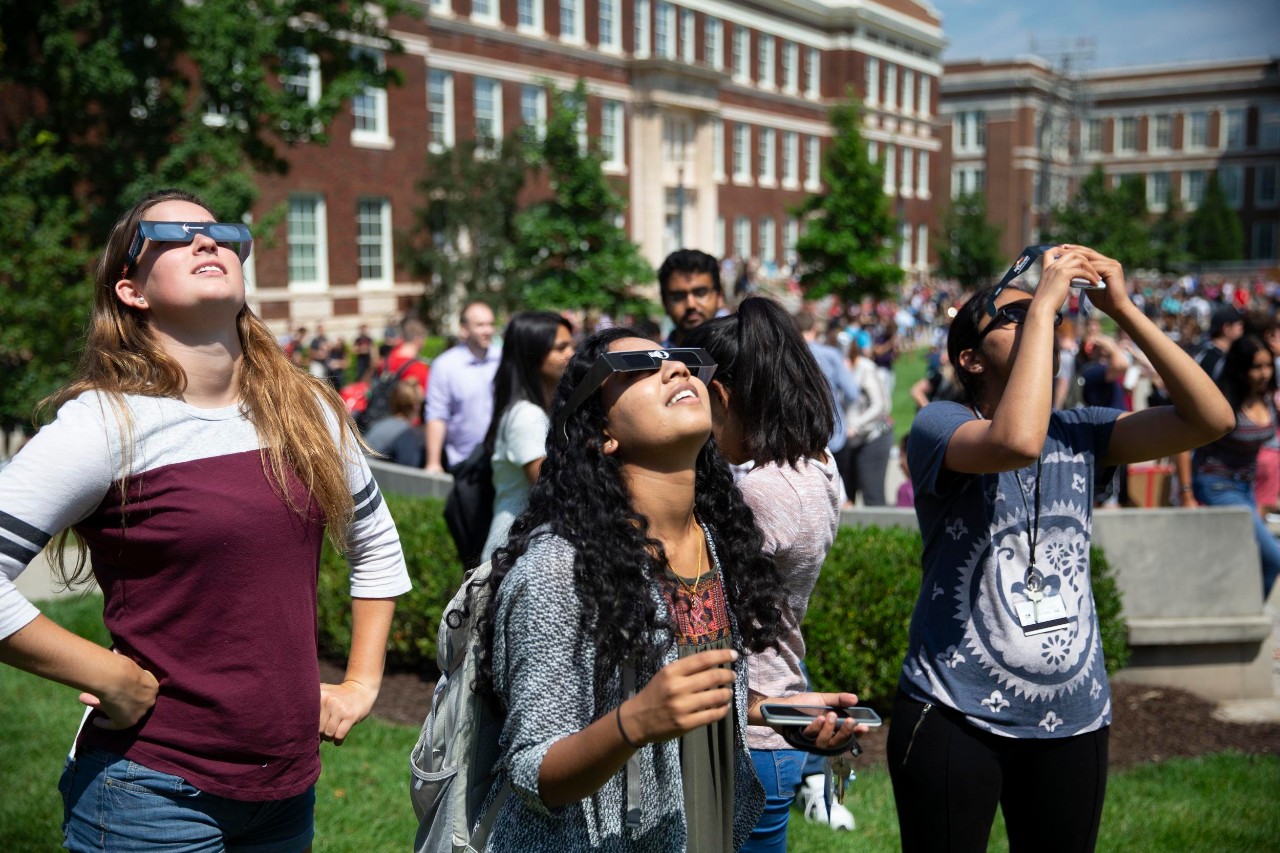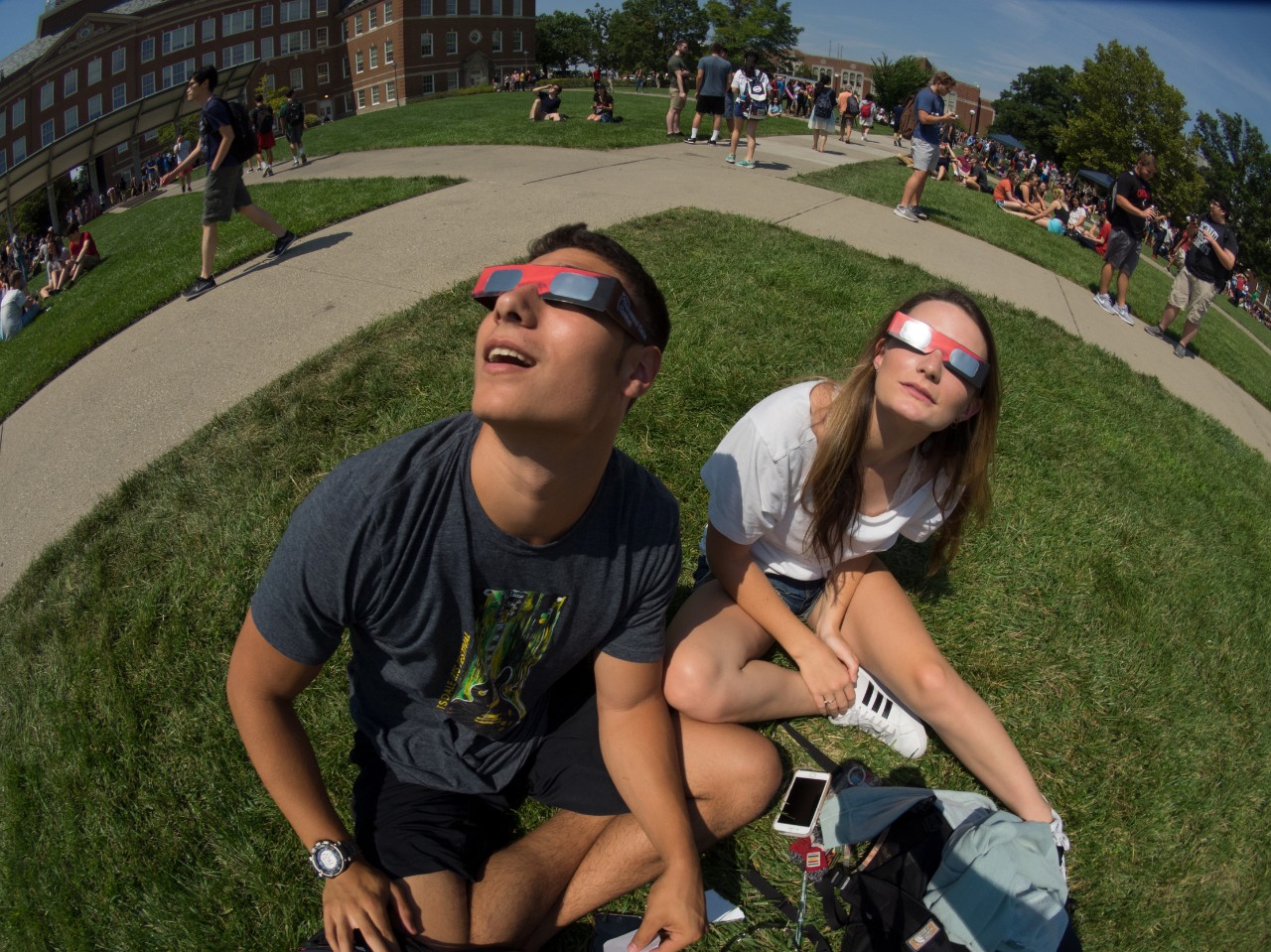
Mother Nature prepares to turn out the lights
Tips for experiencing the solar eclipse on April 8
A partial eclipse of the sun will darken the University of Cincinnati on April 8 for the first time in seven years.
UC last witnessed a solar eclipse on the first day of the fall semester in 2017. Students and faculty spilled out across UC’s Uptown Campus to watch the eclipse using protective glasses, pinhole cameras and other devices to safely observe the phenomenon.
Unlike the 2017 solar eclipse, totality — when the moon completely blocks the face of the sun for a brief time — will be tantalizingly close to Cincinnati.
Here’s what you need to know to safely enjoy the event.

A total solar eclipse will be visible, weather permitting, across a broad section of the United States stretching from Texas to Maine. Map/NASA
What happens during an eclipse?
Solar eclipses occur when the moon passes in front of the sun, casting a shadow across the Earth. Total eclipses are relatively rare, occurring somewhere on Earth only once every 18 months or so. The United States has only seen 21 total solar eclipses since 1776, according to NASA.
Where is the best place to watch the eclipse?
UC Campus Services Marketing will host an eclipse party April 8 from 2 to 4 p.m. on Bearcats Commons. Eclipse viewing glasses will be available while supplies last. The eclipse will reach peak darkness called totality across the Tristate shortly after 3 p.m.
UC Blue Ash also will celebrate the eclipse on Campus Quad between Muntz Hall and Walters Hall from 2:30 to 4 p.m.
The Cincinnati Observatory’s event is sold out. But other local watches will take place at Miami Whitewater Park, Sharon Woods and Parky’s Farm hosted by Great Parks of Hamilton County and Washington Park in Over-the-Rhine, among others.
The path of totality can be viewed from various locations about an hour’s drive north or west of Cincinnati. The eclipse will cut a swath across Ohio from just north of Dayton to just north of Cleveland.
The last total solar eclipse visible in Ohio was in 1806. The next one won’t happen until 2099. And the next total solar eclipse in the United States won’t occur until 2044. So some people are determined to track down the moon’s shadow this time.

Students on UC's Uptown Campus will gather on Bearcats Commons to watch the eclipse on April 8 as they did in 2017. Holes in the leaves of trees cast little images of the eclipse onto the arms of the students. Photo/Lisa Ventre/UC Marketing + Brand
How to protect your vision in an eclipse
The sun emits high levels of ultraviolet radiation, which can cause damage to the cells of your eyes’ surface and the back of your eyes, said Adam Kaufman, MD, interim chair of the Department of Ophthalmology in UC's College of Medicine.
Kaufman offered these tips for eclipse watchers:
- Never look at the sun without proper eye protection.
- Ordinary sunglasses are not safe for looking at the sun. Only use glasses approved by the American Astronomical Society to view a solar eclipse that meet a globally recognized standard.
- Do not use eclipse glasses which have been scratched or damaged and follow the directions that come with them.
- If you normally wear eyeglasses, wear your eclipse glasses over them.
- Pay special attention to children if they are trying to use eclipse glasses while viewing the eclipse.
- When using an unfiltered camera, telescope, binoculars or other similar device, never look at the sun — even during the eclipse. This is important even if you are wearing eclipse glasses as the intense solar rays coming through these devices could damage the protective filter in your solar glasses and put your eyes at risk.
In addition to UV radiation, the sun also emits infrared radiation, which can generate heat. Direct exposure to intense sunlight can cause thermal damage to your eyes, leading to inflammation, tissue damage and discomfort. During the exposure you may be completely unaware that the damage to your eyes is occurring.
Prolonged viewing of the sun could cause solar retinopathy, a condition where the light-sensitive cells in the retina are damaged, which could be permanent. Symptoms of solar retinopathy may not appear immediately after sun exposure and can develop gradually over hours or days. Macular edema may occur from prolonged exposure to the sun during an eclipse. This is a condition where the central part of the retina swells leading to vision distortion and potential permanent damage.
Other eye damage that can occur from exposure to intense UV radiation from the sun could include photokeratitis, also known as “sunburned eyes” or “welder’s flash.”
Should you experience discomfort or vision problems following the eclipse, visit your vision professional as soon as possible. Some common symptoms include loss of central vision, distorted vision and altered color vision.

A map depicts where the solar eclipse will be visible in the lower 48 states. Graphic/NOAA
Why are eclipses so rare?
The moon travels around the Earth in an elliptical, elongated orbit, which means its shadow misses the Earth or casts its shadow from the sun at different points on the globe. A total solar eclipse only occurs during a new moon, when the moon passes between the Earth and the sun.
Why is seeing an eclipse worthwhile?
Assistant Professor Matthew Bayliss teaches physics in UC’s College of Arts and Sciences, where he studies observational cosmology. In 2017, he flew to his parents’ home in North Carolina. They got up early and drove to a small park in the path of totality across the border in South Carolina.
“I didn’t know quite what to expect. I had seen a partial eclipse before. You get the glasses and see a crescent shape on the sun. It’s interesting, but I wouldn’t go out of my way to see a partial eclipse,” he said. “But the total eclipse? That was extraordinary.”
The birds fell silent, roosting in the trees as if it were nighttime. The quality of the light was otherworldly.
“It’s really, really bizarre. It’s one thing to know something, but another to experience it,” he said. “You can totally imagine taking over a civilization if you could convince people you were blocking out the sun.”

Students on UC's Uptown Campus will gather on Bearcats Commons on April 8 to see the solar eclipse. Photo/Jay Yocis/UC Marketing + Brand
What to look for during an eclipse
Bayliss said one fun thing to look for is the way insect-nibbled leaves on trees create tiny pinhole cameras that cast thousands of images of the eclipse on the ground. You can create the same effect by holding up a kitchen colander and seeing the shadows it creates.
The brief period when the sun is completely obscured by the moon, called totality, gives viewers a rare chance to see the corona of the sun, Bayliss said.
“This is really faint compared to the light of the sun. You normally don’t see it because it would be like looking at a match flame next to a spotlight,” he said.
Having seen one, I would drive out of my way to see it again.
Matthew Bayliss UC assistant professor on an eclipse
Prepare for traffic after the eclipse
The Ohio State Highway Patrol says it’s unsafe to watch the eclipse from the shoulders of busy roads and illegal to stop on highways except for emergencies.
Ohio transportation officials are warning people to gas up ahead of time and take their time coming home to avoid the expected gridlock.
“Traffic isn’t the word for it,” Bayliss recalled from his 2017 experience. “Once the eclipse is over, everyone gets in their car to drive home.”
So his advice: Take your time coming back.
“I’d say go someplace and take games and a picnic and plan to hang out for a couple hours afterward,” he said.
Still, Bayliss said it’s worth the effort. He plans to host friends and family for the stellar event.
“Previously, I would have been low-level cynical about the eclipse,” he said. “But having seen one, I would drive out of my way to see it again.”
Featured image at top: As they did in 2017, UC students will gather on Bearcats Commons to watch the solar eclipse on April 8. Photo/Lisa Ventre/UC Marketing + Brand

The sun's corona is visible at the peak of a total solar eclipse. Photo/NASA/Aubrey Gemignani
Become a Bearcat
Whether you’re a first-generation student or from a family of Bearcats, UC is proud to support you at every step along your journey. We want to make sure you succeed — and feel right at home.
Related Stories
Mother Nature prepares to turn out the lights
April 2, 2024
Tips for getting the most out of the solar eclipse that will darken skies over the University of Cincinnati's campus on April 8.
‘Somos familia’
April 26, 2023
“Somos familia” means “we are family,” and students from throughout the Latinx community are building family, finding success and continuing a legacy at UC.
UC Physics hits road to witness solar eclipse
April 9, 2024
UC's Physics Department took students to Blue River Memorial Park in Shelbyville, Indiana, to witness the solar eclipse in the path of totality.
